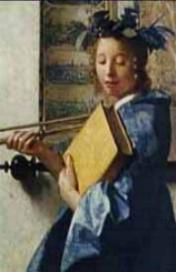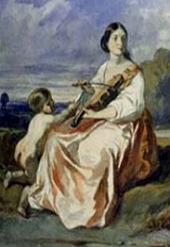These Greek deities of art and inspiration are
among the most familiar of the ancient divinities. Originally there were
only three,
at Mount Helicon: Melete, Mneme, and Aoide. There
were also only three at Delphi: Nete, Mese, and Hypate. There were
seven in Lesbos and in Sicily, and eight in ancient
Athens. Only much later was it agreed that there were the nine we know
today. According to most mythographers they are
the daughters of Zeus and the Titaness Mnemosyne (goddess of memory),
although this view is not unaminous. Some claim
they were the daughters of Uranus and Gaea, others say Pierus and Antiope
(or even him with the nymph Pimplea), and others
say of Zeus and the nymph Neda. The most accepted myth goes thusly: After
the gods defeated the Titans in their epic battle,
Zeus was asked by them to create divinities who would be capable of leading
a
celebratory victory feast. To accomodate them,
Zeus bedded Mnemosyne for nine consecutive nights, whereupon, in due time,
she delivered the nine daughters who were to
become the Muses. The Muses were raised by the hunter Crotus (or Krotus,
who
later became the constellation Sagittarius).
The muses were not always harmonious, joyful and carefree. Like most of
the other
gods they could be vengeful when warranted; when
Thamyris (a famous bard of Thrace) boasted that he surpassed even the
Muses, they struck him blind and dumb, when Pierus
and his nine daughters challenged them in a poetry contest, which was
won by the Muses, they had Apollo change the
nine girls into magpies, and when the Sirens challenged them, and lost,
they had
the feathers of their wings plucked out by the
Muses (therefore, the sirens lost their wings, and the capability of flying,
and the
Muses gained the ability). Originally the Muses
were considered virgin deities, but later myths attributed many love-affairs
to
them. (The Muses were also known by the names
Heliconiades, Parnassides, Carmentae, Pieriades, Aganippides, Castalides,
Maeonides)
![]()
Erato, the Muse of Lyrics
Euterpe, the Muse of Music
Thalia, the Muse of Comedy
Melpomene, the Muse of Tragedy
Terpsichore, the Muse of Dance
Urania, the Muse of Astronomy
Clio, the Muse of History
Polyhymnia, the Muse The
muse of lyric poetry and sacred hymns, and the inventor of the lyre.
Calliope, the Muse of Epics
 Calliope
Calliope
("beautiful voice") is the Muse of Epic Poetry.
Chief and oldest of the nine Muses. She was the
patron of epic poetry.
She is the mother of the poets/musicians: Hymenaeus
and Ialemus (by Apollo), Linus (by Apollo?), and Orpheus (by her
husband, Oeagrus). She was called by Zeus to mediate the quarrel between
Aphrodite and Persephone over possession of Adonis. She settled the dispute
by giving them equal time, and giving Adonis some free time for himself.
She is often shown with a pad and pencil (tablet and stylus) or a book.
 Clio
Clio
detail from "The Allegory of Painting"
The Muse Clio - by Vermeer
("famegiver") is the Muse of History. She is usually
depicted with a laurel wreath on her head and holding a book or scroll.
Her attributes, though, are the trumpet and the clepsydra. Clio teased
Aphrodite about her love of Adonis, provoking Aphrodite's wrath. In
retribution, Aphrodite caused Clio to fall in love with Pierus, the king
of Macedonia, by whom she is the mother of Hyacinthus. Clio has been credited
with introducing the Phoenician alphabet into Greece.
 Erato
Erato
Erato - by Simon Vouet
Erato's name translates as "passionate". She was
the most famous of the Muses. She is the Muse of lyric love poetry and
mime, usually depicted holding a lyre. Clio is another one of the nine
Muses. She was the patron of history, and inventor of historical and heroic
poetry. From a union with King Pierus she bore a son, Hyacinthus. He was
a handsome lad who was killed by his lover, Apollo. From his blood grew
the flower that bears his name.
 Melpomene
Melpomene
Hesiod and the Muse, 1891 -
Gustave Moreau (1826-1898)
Melpomene is the Muse of Tragedies and Elegies. She is usually depicted wearing a tragic mask and vine leaves, and sometimes carrying the club of Heracles. She is the mother, by the river-god Achelous, of the Sirens.
 Euterpe
Euterpe
by Camiile Roqueplan
Euterpe("joygiver") is the Muse of Lyric Poetry.
She is usually depicted holding a flute.
Polyhymnia (POLYMNIA)
Polyhymnia ("many hymns") is the Muse of Heroic
Hymnsand of Mimic Art. She is usually depicted in meditation, with a finger
on her mouth.
Terpsichore
"lover of dancing" is the Muse of Dancing, although
she ruled choral song also. Her attribute is the cithara.
 Thalia
Thalia
("festive") is the Muse of Comedy. She is usually
shown wearing a comic mask and wreaths of ivy and carrying a shepherd's
staff. She is the mother, by Apollo, of Corybantes.
 Urania
Urania
Simon Vouet
detail of Urania from The Muses
Urania and Calliope, c. 1634
("heavenly") is the Muse of Astronomy. She was
often pictured with a globe and a compass.